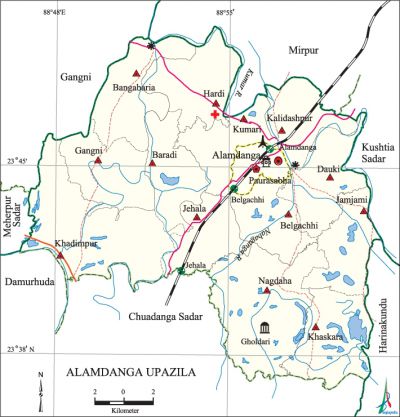Alamdanga Upazila
Alamdanga Upazila (chuadanga district) area 380.38 sq km, located in between 23°37' and 23°50' north latitudes and in between 88°47' and 89°00' east longitudes. It is bounded by mirpur (kustia) and gangni upazilas on the north, harinakunda and kustia sadar upazilas on the east, chuadanga sadar and damurhuda upazilas on the south, meherpur sadar and gangni upazilas on the west.
Population Total 308917; male 158951, female 149966; Muslim 299878, Hindu 8919, Christian 11 and others 109.
Water bodies Main rivers: kumar and nabaganga.
Administration Alamdanga Thana was turned into an upazila in 1982.
| Upazila | ||||||||
| Municipality | Union | Mouza | Village | Population | Density (per sq km) | Literacy rate (%) | ||
| Urban | Rural | Urban | Rural | |||||
|
1 |
13 |
126 |
203 |
69188 |
239729 |
812 |
49.54 |
37.18 |
| Municipality | |||||
| Area (sq km) | Ward | Mahalla | Population | Density (per sq km) | Literacy rate (%) |
|
9.60 |
9 |
18 |
27040 |
2817 |
60.65 |
| Upazila Town | |||||
| Area (sq km) | Mouza | Population | Density (per sq km) | Literacy rate (%) | |
|
46.97 |
14 |
42148 |
897 |
42.26 | |
| Union | ||||||||
| Name of union and GO code | Area (acre) | Population | Literacy rate (%) | |||||
| Male | Female | |||||||
|
Kalidaspur 51 |
- |
10458 |
9886 |
40.36 | ||||
|
Kumari 87 |
5015 |
8841 |
8290 |
42.14 | ||||
|
Khadimpur 71 |
12839 |
20288 |
18595 |
40.76 | ||||
|
Khaskara 79 |
7121 |
10846 |
10079 |
35.5 | ||||
|
Gangni 39 |
9977 |
10627 |
10053 |
40.96 | ||||
|
Jamjami 55 |
5408 |
8906 |
8228 |
37.06 | ||||
|
Jehala 63 |
5091 |
9683 |
8942 |
39.35 | ||||
|
Dauki 31 |
6031 |
8471 |
8465 |
35.58 | ||||
|
Nagdaha 94 |
11867 |
14636 |
13872 |
32.01 | ||||
|
Baradi 15 |
5303 |
8723 |
8257 |
34.26 | ||||
|
Belgachhi 13 |
4671 |
7134 |
7152 |
36.92 | ||||
|
Bhangabaria 23 |
6924 |
12682 |
11748 |
39.16 | ||||
|
Hardi 47 |
6439 |
13922 |
13093 |
37.70 | ||||
Source Bangladesh Population Census 2001, Bangladesh Bureau of Statistics.
Archaeological heritage and relics 'Gholdari Mosque (Nagdaha), Teyorbila Mosque (Khaskarra), Jamjami Mosque, Bademaju Mosque, Sonatanpur Mandir and Gholdari Nilkuthi.
Historical events In eighteen century the peasants of Alamdanga revolted against the indigo plantation. Maheshchandra Chatterjee united the peasants and led armed revolution against the indigo planters. During the war of liberation a number of rajakars and Pak soilders were killed or wounded in frontal encounters with the freedom fighters in Baliapur and Benagari villages.

Marks of the War of Liberation 'Mass grave 1 (on the bank of GK Canal adjacent to the Alamdanga railway station).
Religious institutions Mosque 228, temple 4, church 4.
Literacy rate and educational institutions Average literacy 39.96%; Male 42.92%, female 36.83%. Noted educational institutions: Alamdanga College (1965), M S Joha Degree College (1994), Alamdanga Multilateral (Pilot) Secondary School (1914), Hat Boalia Secondary School (1925), Munshiganj Academy (1944).
Cultural organizations Library 2, club 18, theatre group 7, cinema hall 7.
Main source sources of income' Agriculture 41.76%, non-agriculture labourer 27.35%, industry 0.84%, business 12.54%, service 3.78%, construction 0.87%, religious service' 0.17%, rent and remittance 0.43%, transport and communication 2.89% and others 6.01%.
Ownership of agricultural land Landowner 62.44%, landless 37.56%; agricultural landowner: urban 50.12%, rural 65.93%.
Main crops Paddy, jute, wheat, sugarcane, pulse, potato, corn, gram, tobacco, betel nut, betel leaf.
Extinct and nearly extinct crops' Sesame, mustard, indigo.
Main fruits Mango, jackfruit, papaya, banana.
Fisheries, dairies and poultries Fishery 3, dairy 4, poultry 17.
Communication facilities Pucca road 58.40 km, semi pucca road 45.50 km, mud road 359.50 km; railways 22 km.
Extinct or nearly extinct traditional transport Palanquin, boat, horse carriage.
Noted manufactories Sugar mill, flour mill, rice mill, threshed rice (chira) mill, saw mill, ice factory.
Cottage industries Weaving, blacksmith, potteries, bamboo work, cane work.
Hats, bazars and fairs Total hats bazars are 24, fairs 2, most noted of which are Munshiganj Hat, Alamdanga Hat, Asmankhali Hat, Gokulkhali Hat, Boalia Hat and Baul Mela (Gopinathpur) and Poush Samkranti Mela.
''Main exports Tobacco, betel leaf, betel nut, jute.
Access to electricity All the wards and unions of this upazila are under rural electrification net-work. However 29.15% of the dwelling households only have access to electricity.
Sources of drinking water Tube-well 92.73%, pond 0.07%, tap 0.56% and others 6.64%. The level of arsenic contamination in the tube-well water is 34.94% which is 34.89% higher than normal level. As a result a lot of' people are suffering from many diseases including skin disease.
Sanitation 20.76% of dwelling households (rural 16.40% and urban 36.10%) of the upazila use sanitary latrines and 39.37% of dwelling houses (urban 40.03% and rural 37.04%) use non-sanitary latrines; 39.87% of households do not have sanitation facilities.
Heath centres Upazila health complex 1, health and family welfare centre 14.
NGO activities Operationally important NGOs are brac, asa, care, Wave Foundation, Sajaag, Sreejani. [Md Faysal Kibria]
References Bangladesh Population Census 2001, Bangladesh Bureau of Statistics; Cultural Survey Report of Alamdanga Upazila 2007.
